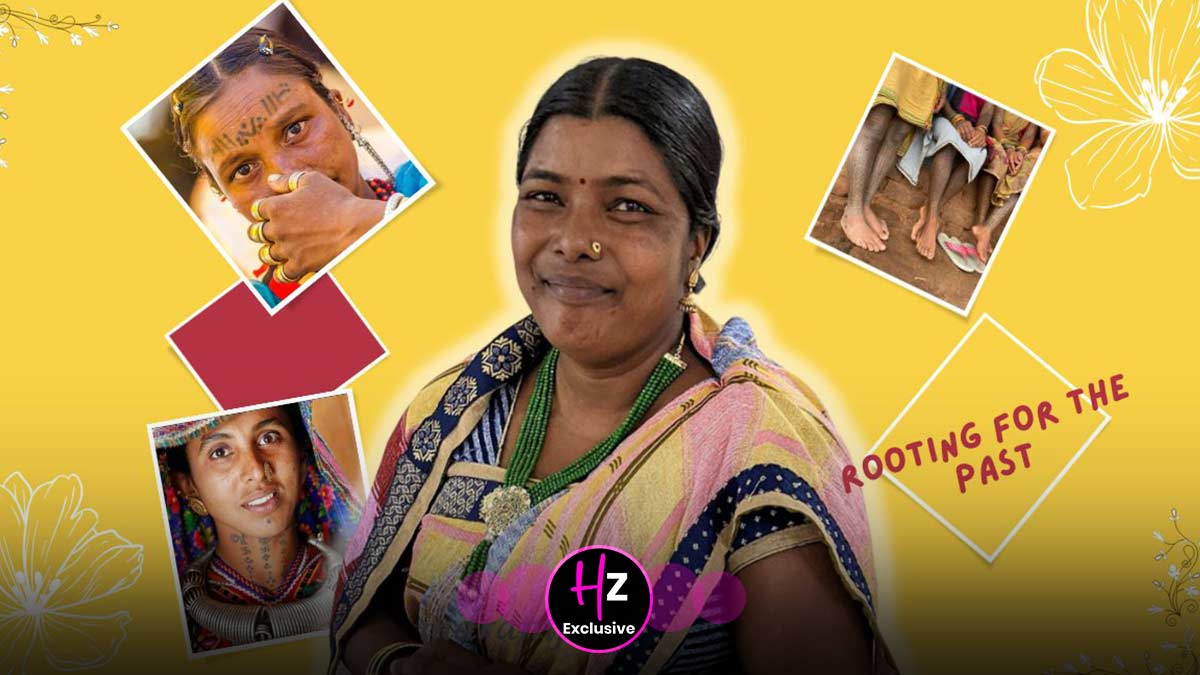
Meet Mangala Bai, A Gond Tattoo Artist Trying To Save Traditional Tribal Art From Fading
‘I want to keep the ancestral art of traditional tattoo designing alive,” said Mangala Bai, a Gond tattoo artist, with a hint of sorrow and pride in her voice.
India is home to several tribal communities that have their own culture, language, beliefs and traditions. Many of these communities still continue to follow a lifestyle that their ancestors had taught them, while others have accepted the modern way of living, advanced machines and new sources of employment.
In the midst of all this is a woman in Madhya Pradesh striving hard to protect the traditional way of designing a tattoo. She is trying to preserve the art that seems to be diminishing in today’s fast paced world.
Centuries-Old Tattoo Art

Mangala Bai says that the traditional art of the Gond and Baiga community to design tattoos dates many centuries back when there were no skyscrapers, automobiles or advanced machinery known to mankind.
“My forefathers, their forefathers, their forefathers and even the ancient times when there were no cemented houses, and our community used to live without proper clothes, my ancestors used to design tattoos for people of other communities.”
She and her father are skilled to use a machine to ink tattoos, however, she prefers the age-old method of using kajal to craft the design and ram bans ka kanta (bamboo thorn) to pierce the skin and make it permanent.
1
2
3
4
Mangala Bai does not like to use any chemicals, even the kajal is homemade. She uses kala til (black sesame seeds) to prepare it. First, she roasts the seeds, crushes them, adds a small amount of sesame oil and burns them in a clay pot. From there, she collects the black deposits that serve as organic kajal, which becomes permanent on the skin when thorns are pierced into it.
Relationship Between Gond And Baiga

In ancient times, the Baiga community was referred to as Nana Baigans. Those were the people who used to serve the earth and its natural elements like water, soil and trees.
According to tales, the king of the Baiga community wanted to impress Lord Indra, the God of Rain and Thunder. Since he had nothing unlike rich people, someone suggested he get a tattoo all over his body. Seeking help from tattoo designers, he got his entire body inked to impress the Lord.
‘I Was Seven When I Started Designing Tattoos’

Mangala Bai was only seven when she started designing tattoos. She learnt it by seeing his parents. Her mother or father used to draw the design, and she used to carve it using the thorn of bamboo.
When Mangala Bai was a little girl, she could not stand and design tattoos at the same time, given her height did not allow her to do it efficiently. “I used to stand on a chair and carve the tattoo,” she added with a chuckle.
The communities have traditions to get inked at various stages of life. For example, people of the Gond community get newborns carved with three small dots. Among Baigas, girls at the ripe age of nine start getting tattoos on their bodies. At the age of 12, they get their backs inked, at 13, their legs get tattooed, and after marriage or having a baby, they get their chests tattooed. This way, they get their entire body inked over time, except for their abdomens.
Don't Miss: 15 Women Who Were Founding Mothers Of The Constitution Of India
Unmarried & A Mother

Mangala Bai has three sisters, all married. She opted out of marriage (why I prefer to stay single) when her mother became unwell. She took on the family business and now goes from village to village, city to city designing tattoos when a client asks her for assistance.
She adopted her sister’s son, who is now married and a parent but does not have any interest in the ancestral art. Mangala Bai is not educated, but she does know the value of traditional art that is fading. Hence, she has been doing her best to preserve it for as long as she can.
Despite knowing how to use a machine, Mangala Bai claims that she can carve intricate as well as broad designs using the traditional process. “I want to promote the art, therefore, I do not use a machine for work.”
Don't Miss: Novelist, Poet Sahana Ahmed Talks About World Peace & Gender Equality
Healing Powers Of Tattoos

Mangala Bai proudly claims that the traditional art of tattoo designing prevents infections from developing. She also shared with us that many tattoo artists can help find relief from back pain, neck pain and knee pain among other ailments.
Tattoo artists in the community charge a certain amount for healing people. However, Mangala Bai does it for free.
Since most people in the communities are opting out of getting their bodies inked nowadays, Mangala Bai is left with only a few customers. In an effort to keep this ancestral art alive, she now paints the design on canvases and sells these paintings. Nesco is helping her reach more people so that more souls can join her mission.
Also watch this video
Herzindagi video
1
2
3
4